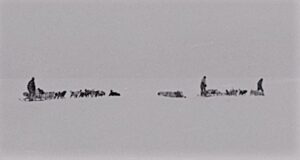‘Traveling to Antarctica Christmas 2005’ Category
» posted on Monday, December 28th, 2020 by Linda Lou Burton
Beam me up, Scotty
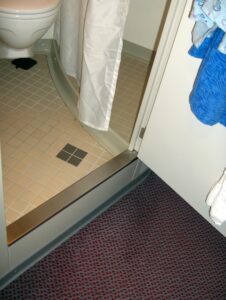 Originally posted December 28, 2005 by Linda Lou Burton from Drake Passage, Antarctica – The rolling woke me up at 3 AM. The sun outside revealed the waves. Waves, and nothing but. I reached for the wristbands, pulled the covers up. I woke at 5, and then again at 7. The ship was rolling, swaying, natural for open waters, not natural for a land-lubber like me. At 8 I’m up, I showered leaning in the corner of the stall.
Originally posted December 28, 2005 by Linda Lou Burton from Drake Passage, Antarctica – The rolling woke me up at 3 AM. The sun outside revealed the waves. Waves, and nothing but. I reached for the wristbands, pulled the covers up. I woke at 5, and then again at 7. The ship was rolling, swaying, natural for open waters, not natural for a land-lubber like me. At 8 I’m up, I showered leaning in the corner of the stall.
Waffles in the dining room, I made it, hand to hand and rail to rail. The waffles smelled so good, but I did not think I could make it to the plates. “I will bring it to you, Madame,” said the waffle maker, “would you like syrup?” I sat down, gratefully. The coffee sloshed in my cup. Would my glass of water tilt? I held it with one hand, fork in the other, ate.
“Hell Served for Breakfast: Tales of the Aurora” was the lecture for the morning. Our leader Ian was to tell the tale, in Torghatten Salong. I went, sank into a seat close to the door. Ian lifted the mike, surveyed the green-faced crowd, chuckled wickedly. “One of you will leave,” he said. “I guarantee it. At least one of you will have to leave.” The tale began, explorers, hardship, winter winds, disaster. “The dogs were starving, the men were too. Wild loaded all the good supplies on one sled, pulled by six strong dogs; the weaker dogs were hitched to less important things.” Which sled went over the crevasse?
The good one of course (guess Wild had never heard of Aesop’s basket of eggs, eh?). The men were left with no food, six starving dogs. One dog died that night, they cut him into pieces. The dog was tough, the men could hardly chew. They boiled the feet, made a gel of doggie paw. They ate the liver.
“I’ll be your first to go,” a lady near the front stood up, and left. Ian chuckled, continued. “The men were sick. Their skin fell off. Their mustaches fell off. They lost the soles of their feet. They were coming apart. Wild taped the soles of his feet back on, crawled miles and miles on hands and knees.” An aside here: Ian explained that sled dogs store high amounts of Vitamin A in their liver, toxic to humans. It was the doggie liver that made the men ill, not the doggie-paw gel. Good to know.
Ian ended his tales of heroic explorers with a poem about “fighting to the end, never quitting.” I had made it to the end. I am heroic, I thought, as I bumped into the wall, slung myself towards the door, grabbed a post. Betty, waiting by the elevator, put out her hand for me. I made it to my room, and slept.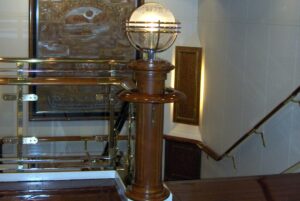
A bite of lunch before they closed the doors at 2. I wanted to hear the lectures, divert my mind. Manuel would tell us more about penguins today. Name and Naming was the title of his talk. Hand to hand and chair to chair, I made it to the front of the room.
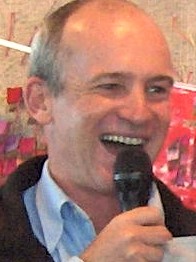 On the board Manuel had written: Pen-gwyn, Pin-wing, Pinguis. “Welcome to Penguin 505,” he said. “Today we will talk about how penguin was name.” He pranced side to side, ready to challenge us. “Who can tell the first OCCIDENTAL man who saw the penguin?” he asked, looking at our faces, who would know?
On the board Manuel had written: Pen-gwyn, Pin-wing, Pinguis. “Welcome to Penguin 505,” he said. “Today we will talk about how penguin was name.” He pranced side to side, ready to challenge us. “Who can tell the first OCCIDENTAL man who saw the penguin?” he asked, looking at our faces, who would know?
I was sure I had the answer. “Magellan!” I said proudly. “You go to the water!” he shouted. “No!”
“Drake?” said someone else, “Darwin,” said another. “Oh! You go to the ice! Wrong you are wrong! Oh! No one knows!” he shook his head. We were bewildered, out of names.
“Columbus?” quietly said. Manuel rolled his eyes. “Columbus? He went to tropics, not to cold waters!” “Vikings, then?” I tried again. Manuel did not like that answer either.
“You are thinking the wrong place,” he told us. “It was South Africa! Vasco da Gama!” Strutting proudly, he knew he’d fooled us all.
“Now, who was first Occidental man to see penguin in South America?” he challenged again. I was quiet, this time. No one else answered, either. In disgust he told us, “Magellan! You know your history! Magallenic penguins I have told you before!”
“I was afraid to say it again!” I said. Manuel patted the top of my head. “Magellan, now you know.” Now I know. I think I passed Penguin 505.
But I have not passed Seaworthy 101. I went back to my room, and slept again. Tonight, no dinner for me.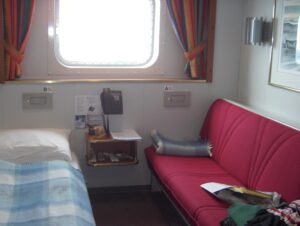
A quote on our handout attributed to Deborah Harler says it all: If 70% of the earth’s surface is covered by water, how come so much of it seems to be between the Antarctic Peninsula and the Beagle Channel?
Beam me up, Scotty.
» posted on Sunday, December 27th, 2020 by Linda Lou Burton
Neither rain, nor sleet, nor blowing snow…
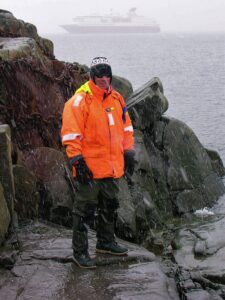 Originally posted by Linda Lou Burton December 27, 2005 from Port Lockroy, Goudier Island and Neko Harbour, Andvord Bay, Antarctica – Today was a little bit boring, actually. Well, except for Mother Nature and her whims. She kept our leader on his toes! The sun was hidden by low clouds and blowing snow for our breakfast view, but the winds were not too strong for a landing at Port Lockroy.
Originally posted by Linda Lou Burton December 27, 2005 from Port Lockroy, Goudier Island and Neko Harbour, Andvord Bay, Antarctica – Today was a little bit boring, actually. Well, except for Mother Nature and her whims. She kept our leader on his toes! The sun was hidden by low clouds and blowing snow for our breakfast view, but the winds were not too strong for a landing at Port Lockroy.
“Group 3 proceed to the Departure Deck,” was the first announcement. I could see a tiny building perched on the rock ahead, Base A, the handout said, on Goudier Island. The building housed a museum and post office, managed by Antarctic Heritage Trust as a historical site. I’d already handed over the 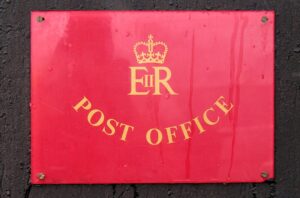 postcards I wanted to mail, our Purser would make sure to deliver them for the precious stamp “Antarctica.” Nine postcards for me, $2.00 each. From the ship a total of 1,800 postcards were presented – a good day for the southernmost post office in the world! No automation there; hand canceled, each. Expect them to be delivered by Eastertime, we were told.
postcards I wanted to mail, our Purser would make sure to deliver them for the precious stamp “Antarctica.” Nine postcards for me, $2.00 each. From the ship a total of 1,800 postcards were presented – a good day for the southernmost post office in the world! No automation there; hand canceled, each. Expect them to be delivered by Eastertime, we were told.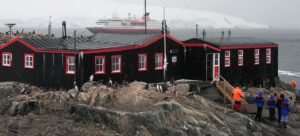
I watched the PolarCirkels back and forth, snow flurrying around, but most folks, like me, settled with their books, and cameras, content to stay aboard. It was good our group was small, Goudier Island is very tiny and half of it is off limits as a Site of Special Scientific Interest (SSSI). Too many tourists! There is a study now to see how visitors affect the nesting penguins. On one side tourists are allowed, the other, no.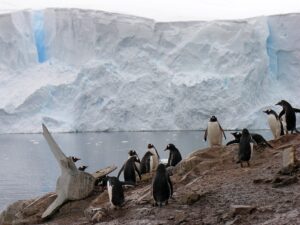
Another announcement. “If you please to use your credit card in the gift shop on shore, you will buy the minimum of $100. Otherwise take cash.” I thought of Christmas sales back home. Shopping! Not for me. Soon everyone was back, and lunch was served.
 Our leader Ian had raved about LeMaire Channel for days. He put this on our handout for 14:30 today, our approximate arrival time: First sighted by Dallman in 1873 and then charted and traversed in 1898 by Adrien de Gerlache who named it for Charles LeMaire, a fellow Belgian who explored the Congo. (?? My thought – what has that to do?) The steep cliffs and glaciers of Booth Island to one side mirror the opposite shores of the Antarctic Peninsula. So much film is exposed in the area of the LeMaire that it is known by expedition staff as “Kodak Crack” or “Fujifilm Gap.”
Our leader Ian had raved about LeMaire Channel for days. He put this on our handout for 14:30 today, our approximate arrival time: First sighted by Dallman in 1873 and then charted and traversed in 1898 by Adrien de Gerlache who named it for Charles LeMaire, a fellow Belgian who explored the Congo. (?? My thought – what has that to do?) The steep cliffs and glaciers of Booth Island to one side mirror the opposite shores of the Antarctic Peninsula. So much film is exposed in the area of the LeMaire that it is known by expedition staff as “Kodak Crack” or “Fujifilm Gap.”
In my Lonely Planet book is this: This steep-sided channel – just 1,600 mm wide – runs for 11 km between the mountains of Booth Island and the Peninsula. The passageway is only visible once you’re nearly inside. Unfortunately, ice sometimes blocks the way, so ships may be forced to retreat and sail around Booth Island. At the northern end of the channel are two tall, rounded, and often snowcapped peaks at Cape Renard.
What do you think happened to us today? What? What? On this day of blowing snow and fog? Aha! You guessed! Mother Nature sent Ian scurrying back to his planning board. ICE BLOCKED OUR WAY! We could not enter LeMaire Channel.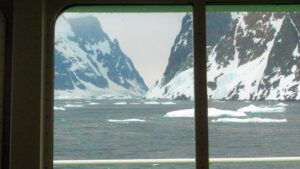
I think this was our most excitement yet. Everyone gathered in Torghatten Salong as we approached, cameras in hand. We ran to one side, then the other, as icebergs scraped against the ship with crunching noise. Closer, closer, but plain to see. Ice everywhere ahead. Announcement. “Ladies and Gentlemen, we must turn the ship around.” Slowly we began to spin, floating in a pot of iceberg soup. The cameras clicked.
“We’ll go instead to Andvord Bay,” Ian announced, ten minutes later, “we’ll stop in Neko Harbour, an incredibly beautiful spot.” The pepping up, all part of the job. No disappointment, just a switch. Plan B.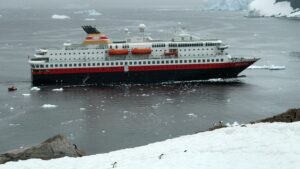
At 5 PM (excuse me, 17:00) the PolarCirkels were ready, the Hardy Bunch began to go ashore. I watched from my warm spot, a funny sight. Through the camera zoom I saw a procession of blue on the snow, walking up the hill; and right beside, a shorter procession of black and white. Big human arms swinging back and forth, little penguin arms flapping, what a sight. It made me laugh.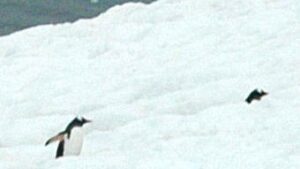
The blue boobies (sorry, I think that would be the Galapagos), the blue PROCESSION in their Voyage of Discovery Antarctica jackets climbed to the top of the snow mountain, looked like little ants, plodding to the top, then rolling down, tumbling over in the snow. The penguins, meanwhile, kept feeding chicks, an ordinary day.
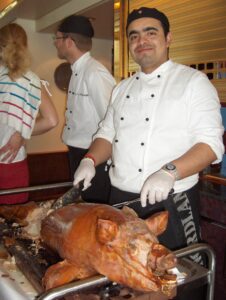 Dinnertime for us. Filipino night, in honor of our housekeeping crew. Lumpia! Pancit! Chicken with pineapple (they called it sweet and sour); exquisite flan. I am very happy and I eat too much. Bedtime and I’m stuffed.
Dinnertime for us. Filipino night, in honor of our housekeeping crew. Lumpia! Pancit! Chicken with pineapple (they called it sweet and sour); exquisite flan. I am very happy and I eat too much. Bedtime and I’m stuffed.
Announcement on the intercom: Four whales are swimming on Port Side, if you want to come and see. I threw on sweatpants, sweater, slung the door-card around my neck, both cameras in my hand, no shoes, just socks. Please believe, I saw the whales. Thirty minutes of video, you see the waves, a spout of water, a gentle rise, the flip of tail, the whale is gone. A whale’s lung capacity is large, very large. They do not come up again for many, many minutes. No use, I thought, to try the still camera, I’d never get the timing right. Pamela watched, tried, John had his nose pressed against the window, we waited, another sighting, gone again.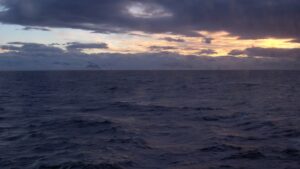
I live near whales! One day I’ll take the charter boat and see the Orcas, Puget Sound. But now I’m in Gerlache Strait, with whales and icebergs floating by.
Did I say this was a boring day?
» posted on Saturday, December 26th, 2020 by Linda Lou Burton
Glissading in Paradise
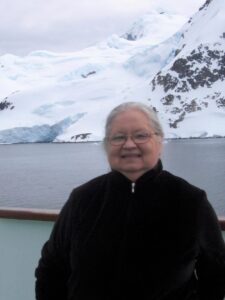 Originally posted December 26, 2005 by Linda Lou Burton from Culverville Island, Paradise Harbor Mainland, Leith Cove, Antarctica – Today, I had to recharge both camera batteries in the middle of the day. A first! But think of this. Think of a day that will still make you smile when you are very old, when you are very gray. Today was one of those.
Originally posted December 26, 2005 by Linda Lou Burton from Culverville Island, Paradise Harbor Mainland, Leith Cove, Antarctica – Today, I had to recharge both camera batteries in the middle of the day. A first! But think of this. Think of a day that will still make you smile when you are very old, when you are very gray. Today was one of those.
Last night’s voyage was rock and roll, a bunk-ride, according to the slang. Today, in the Errera Channel between Ronge Island and the Arctowski Peninsula, the waters were as calm as glass, the sun was breaking through. I rushed out to the upper deck, the fresh air, my sweater warm enough. Pamela and John were there already, smiling, snapping pictures, running from one side of the ship to the other. We swapped cameras for a pose. Let’s prove that we were there! Mountains behind, too picturesque for words. Mountains around, white glass, glaciers, icebergs floating everywhere. A landing there, then lunch, the ship moved on.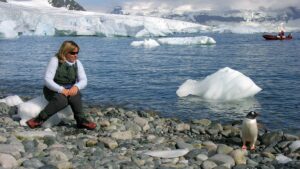
In the middle of dessert, we rounded Waterboat Point. Oh my! Forget dessert! Grab the cameras, head for the deck! Paradise Harbour. “Aptly named,” our handout warned. Aptly named, indeed! Ahead, a cluster of red buildings against the snowbanks; it’s Almirante Brown, a now unmanned Argentine base. Unmanned, that is, except for penguins, uniformed in black and white, pacing back and forth, flapping to the ship. “Come in!”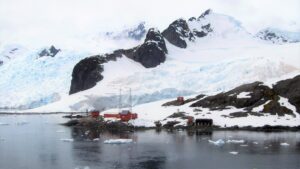
The afternoon turned out to be the best yet of the trip. The PolarCirkels hurried back and forth, one group to shore, another back. Special arrangements for Jan, her cane and walker  placed aboard a boat on deck, then gently lowered to the water, no steps! The steep hill above the base was lined with those ambitious for a climb; reward a smooth glissade back to the bottom on the snow. “No, some rocks!” Bjoern reported back to me. “I hit some rocks.” Paul was prepared. “I stuffed my pants with sweaters,” he laughed, “to protect my bum.” They are young, and full of energy. The older crowd stayed at the bottom, walking in the snow. Pamela lost her boot. “Someone had to pull it out of the snow for me,” she said. “Someone had to pull ME out,” Ross laughed. “I walked to where the children were making a snowman and sunk, three feet down.”
placed aboard a boat on deck, then gently lowered to the water, no steps! The steep hill above the base was lined with those ambitious for a climb; reward a smooth glissade back to the bottom on the snow. “No, some rocks!” Bjoern reported back to me. “I hit some rocks.” Paul was prepared. “I stuffed my pants with sweaters,” he laughed, “to protect my bum.” They are young, and full of energy. The older crowd stayed at the bottom, walking in the snow. Pamela lost her boot. “Someone had to pull it out of the snow for me,” she said. “Someone had to pull ME out,” Ross laughed. “I walked to where the children were making a snowman and sunk, three feet down.”
Ah, summer in Antarctica. The sun kept shining.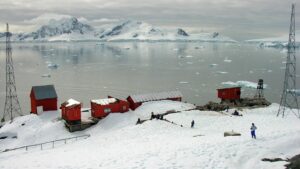
Everybody back on board, move on. Announcement: we will anchor overnight at Leith Cove. Dinner over, took my book and cameras to Torghatten Salong, the observation deck, window views wide-angled. Sat down. The water reminded me of a toy, a mirror for a lake, it was so smooth. The mountains turned to doubles, the mountain up, reflection down. Pink clouds, blue icebergs, a thunder crash as pieces fell.
A seal slumbered on a floating chunk. The sun did not set at all. At midnight I forced myself to go to bed.
» posted on Friday, December 25th, 2020 by Linda Lou Burton
That Old Time Rock and Roll
 Christmas in Antarctica originally posted by Linda Lou Burton December 25, 2005 from Port Foster, Deception Island, Antarctica – Kiddies all over the world spend Christmas afternoon playing with their new toys, or scowling about their new sweater from Auntie Marge, wondering why she didn’t send something they really needed, that is, electronic. The kiddies on our ship spent the afternoon inside a volcanic caldera. I don’t know how many of them went ashore, but even if they didn’t, it was a beautiful sight. Myself, I viewed it from the ship but offer photos taken by the crew.
Christmas in Antarctica originally posted by Linda Lou Burton December 25, 2005 from Port Foster, Deception Island, Antarctica – Kiddies all over the world spend Christmas afternoon playing with their new toys, or scowling about their new sweater from Auntie Marge, wondering why she didn’t send something they really needed, that is, electronic. The kiddies on our ship spent the afternoon inside a volcanic caldera. I don’t know how many of them went ashore, but even if they didn’t, it was a beautiful sight. Myself, I viewed it from the ship but offer photos taken by the crew. 
We came into this great natural harbor through a 200-meter-wide entrance known as Neptune’s Bellows, for the winds which often howl through. Once inside, perfect calm. We anchored at Port Foster, the name given the waters inside ring-shaped Deception Island. A volcanic caldera! The last eruption was 1970, and most of the damage done was due to a massive mudslide. Home to British, Norwegian, and Australian whalers or researchers at various times during the past, it’s mostly a tourist stop now.
Main attraction: swimming! Steam vents from the volcano offer waters warm, bubbling from the black volcanic sands. Did our contingent swim today? Ya, you betcha! Ten brave and hardy souls came back bragging, grinning big, the Australians, we are told.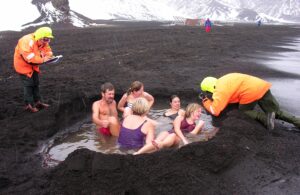
Coffee and Christmas cakes on Dekk 7, to celebrate. Then time to leave. The ship moved out into Bransfield Strait, then on to Gerlache, headed towards the Antarctic Peninsula itself. We hit open waters, during the dinner buffet.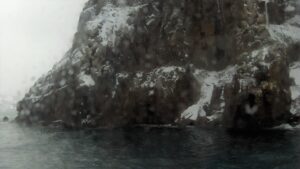
The ship swayed left, the ship swayed right. Passengers with plates full of pickled herring grabbed the railing, knees buckled, hang on tight. The servers managed better, more accustomed to the movements of the ship. Still, there was a crash, a stack of glasses broke against the floor.
I had my wristbands on, pressing tight against the acupressure point. Do not get seasick, I told myself. We laughed at each other, “Get the fork into the mouth. Don’t miss!” The water sloshed back and forth inside our glasses. Some bites of bread, that is all I wanted. “It’s better to be seasick with your stomach full,” I’m told. I ate some more.
My room. That is where I wanted to be. I grabbed the handle of the dining room door, went hand to hand from rail to rail. To the stairway, down one floor. The hallway to my room is fitted with good railing, which I held to tightly.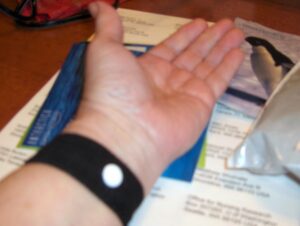
There’s the bed. I am there now. And there I stay. Rock and roll. Burp.
» posted on Friday, December 25th, 2020 by Linda Lou Burton
Manuel and the Hoochy Coochy
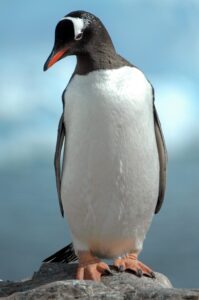 Christmas in Antarctica originally posted by Linda Lou Burton December 25, 2005 from Hannah Point,
Christmas in Antarctica originally posted by Linda Lou Burton December 25, 2005 from Hannah Point, 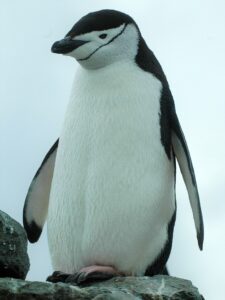 Livingston Island, Antarctica – Christmas Day! We wake up at Hannah Point, known as the “jewel in the crown” of the Antarctic for its diversity of species and glorious scenery. Named for the Hannah, a sealing vessel, it is home to three species of penguins — Gentoo with their striking orange beaks, Chinstrap with a “strap” of black feathers under their chin, and Macaroni with their yellow rock-star hairdo.
Livingston Island, Antarctica – Christmas Day! We wake up at Hannah Point, known as the “jewel in the crown” of the Antarctic for its diversity of species and glorious scenery. Named for the Hannah, a sealing vessel, it is home to three species of penguins — Gentoo with their striking orange beaks, Chinstrap with a “strap” of black feathers under their chin, and Macaroni with their yellow rock-star hairdo.
The clouds have moved in today, the temperature has dropped to 33 F, and, to the delight of many who have never had a White Christmas, it is snowing! A light snow, faintly blowing across the deck, but snow, nonetheless.
For certain, I will enjoy the delights of Antarctica from the warmth of the Torghatten Salong today, sitting in a comfy chair with cameras occasionally recording the magnificent view.
And, writing. There is a contest! Manuel Marin has challenged us. Manual is part of our lecture/teaching staff, an Ornithologist from Chile (PhD from LSU!), a researcher of neotropical birds. So far, his lectures have included: Cormorants, the Untold Story; Penguins, Those from the other side; Penguins, The brush-tailed, Life and Death Part 1; Penguins, The brush-tailed, Life and Death Part 2. Manuel knows penguins. His lectures are  entertaining: he passes around penguin parts for us to see (see the foot, they are very sharp!); he giggles as he shows us slides of penguins mating (ooo, Triple X, ladies cover your eyes!). “Pebbles are like diamonds,” he explains, describing a penguin nest. “The male offers a pebble to a female during the courtship ritual. These are of utmost value! Better than chocolates! Better than Chanel #55! So good!”
entertaining: he passes around penguin parts for us to see (see the foot, they are very sharp!); he giggles as he shows us slides of penguins mating (ooo, Triple X, ladies cover your eyes!). “Pebbles are like diamonds,” he explains, describing a penguin nest. “The male offers a pebble to a female during the courtship ritual. These are of utmost value! Better than chocolates! Better than Chanel #55! So good!”
Without the pebbles, there is little protection for the egg. A pile of pebbles makes for good drainage too. An egg left sitting on bare ground is more likely to freeze, or crack. “You think it is OK to take one pebble home?” Manuel asks us, looking stern, searching for a guilty face. “You think one pebble will not matter?” A pause. “Twenty-four thousand visitors came to Antarctica last year. If each person took ONE PEBBLE, what would happen to the beach! What would happen to the penguins! Do not take the pebbles! Do not pick up the feathers! If you promised this to your grandchild, instead, tell your grandchild how you helped a penguin to have life! You saved the egg!”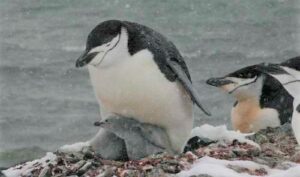
Manuel paced around the room. Did he make his point? Still, Manuel wants us to think more. To understand the penguin. So, now there is a contest. All around the ship he posted signs, in English and in German.
Contest!
Prizes for drawing, sculpture, poem about birds!
Deadline December 28!
Pamela has been working on a cross-stitch penguin piece, sitting in her favorite chair each 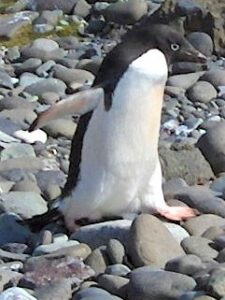 day near the cakes and tea, beside the “cleanest window,” she reports. Doug sits near there too, his watercolors spread on the tabletop, brushing daily memories onto paper. I’m sure he’ll have a beautiful bird to submit.
day near the cakes and tea, beside the “cleanest window,” she reports. Doug sits near there too, his watercolors spread on the tabletop, brushing daily memories onto paper. I’m sure he’ll have a beautiful bird to submit.
I can’t sew, or paint. But I like to write. Especially humorous takeoffs on the Night Before Christmas, at least, at Christmas time. Hmmmm, I’m thinking, as I see the penguins walking, far away, along the beach. In my mind I see the little Adelie penguin who passed me by the day before, hobbling and hopping over the rocks, her tiny wings an afterthought by her creator? Penguins. They can swim, but they can’t fly. What might a penguin wish for? I began to scribble, on a yellow pad…
- ‘Twas the night before Christmas, and all through the ship, every creature was stirring, celebrating their trip!

- But the penguins were nestled, all snug on their nests, having spent the day hosting, the Nord-nor-gay as guest.
- Adelie and gentoo, they welcomed our walk, enduring the kameras, with barely a squawk.
- On came Evie and Stevie, on came Lily and Luke, with a flap and a waddle, then the Duchess, and Duke.
- With pebbles like diamonds, all piled in a stack, each went for their lunch, and then each came back.
- No dishes to wash, no laundry to do, the life of a penguin, seems all lovey, and woo.
- When the spring light first came, and the weather got dandy, the Lukes and the Lilys, began to get randy.
- Hey baby! They called, You are looking so fine, take this pebble of love, and you can be mine.
- Oh hoochy! Oh coochy!, Stand still! I’ll be quick. But Lily is fickle. Did Luke give her a chick?
- Footprints on her back, show she’s tried it before. It’s only insurance! Our sweet Lily’s no whore!
- The wedding is over, the nest is complete. Lily sits like Queen Sheba, piles of rocks at her feet.
- Luke stands guard for the skua, They both watch for the seal. The egg and the instinct are honored, with zeal.
- Some penguins are jealous, They had no such luck. They sneak to steal pebbles. They fuss, and they cluck.
- But Lily is fearless and Luke remains cool. The egg is kept warm. It’s their asset, their jewel.
- Peck Peck! I want out! Little chickie appears. Papa checks chickie’s feet, Mama checks chickie’s ears.
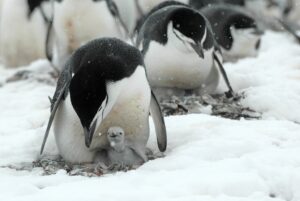
- Lily Penguin suggests, Let’s name our boy Lars. Papa Luke puffs his chest as he hands out cigars.
- Luke and Lily soon learn to their major surprise, now that chickie is born no more closing their eyes.
- Peep Peep! I want food! Bring me something to eat! Luke and Lily grow weary, nearly dead on their feet.
- Soon Lars becomes fuzzy. A mass of gray fat. Luke and Lily agree, That’s enough now, of that.
- So Lars learns how to swim. How to catch his own krill. Lars doesn’t mind that, but he dreams bigger, still.
- For the one thing he sees as the days pass on by, are the birds with big wings, soaring high in the sky.
- He stands on a rock, he jumps with a flap, but the beach comes to meet him, and he lands with a blap!
- He tries and he tries it. He jumps and he wishes. He thinks not of krill. Or even of fishies.
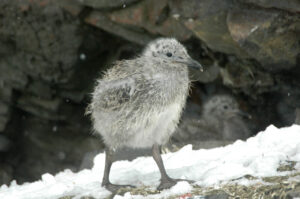
- I KNOW I can do it! I know there’s a way! I want to look down, on the ice, and the bay.
- The other chicks mock him. Even Lily and Luke wonder what they did wrong. Why is their boy a fluke?
- Now Christmas Eve’s here. Lars is sleeping, and dreaming. And Santa is near, hearing wishes, and scheming.
- Then, while the ship parties, drinking, eating, and singing, Santa stops on a glacier, sleigh bells tinkling and ringing.
- Come here Lars! He says quickly, Come and get in my sleigh, I will take you up flying, Up up up, and away!
- More rapid than skuas, his coursers they flew, and Lars knew at that moment, heartfelt wishes come true!
- The penguins below, saw Lars wave from his flight, as he called, “Happy Christmas! And to all, a Good Night!”
I decided to hand it in. I named it “The Rime of the Misunderstood Penguin,” with a special Cootchy-Coo Dedication to Manuel Marin.
Wish me luck!
» posted on Thursday, December 24th, 2020 by Linda Lou Burton
God Jul / Frohe Weihnachten / Feliz Navidad
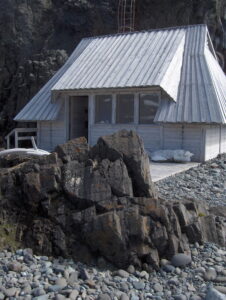 Christmas in Antarctica originally posted by Linda Lou Burton December 24, 2005 from Discovery Bay, Greenwich Island, Antarctica – I’ve never had a Christmas Eve like this one. A morning landing in Admiralty Bay, a meeting of the penguins, a talk with Mario, who is stationed at Poland’s Arctowski station for the next year. “I learned English from the TV,” he told me, apologizing frequently when he couldn’t remember a word he wanted to use. He is studying glaciers, sedimentation. “But travel is my passion,” he confessed. He told me of all the places he has already been, this slender young man of no more than twenty-five. We talked about our Christmas traditions. “The Americans from Copacabana Station are coming tonight for a Christmas Eve party,” he said. “Today, we cannot eat meat, only fish, but tomorrow we will have turkey.” We stood on the deck of the tiny wooden hut under the lighthouse, whale bones strowed around, penguins waddling by, icebergs floating near.
Christmas in Antarctica originally posted by Linda Lou Burton December 24, 2005 from Discovery Bay, Greenwich Island, Antarctica – I’ve never had a Christmas Eve like this one. A morning landing in Admiralty Bay, a meeting of the penguins, a talk with Mario, who is stationed at Poland’s Arctowski station for the next year. “I learned English from the TV,” he told me, apologizing frequently when he couldn’t remember a word he wanted to use. He is studying glaciers, sedimentation. “But travel is my passion,” he confessed. He told me of all the places he has already been, this slender young man of no more than twenty-five. We talked about our Christmas traditions. “The Americans from Copacabana Station are coming tonight for a Christmas Eve party,” he said. “Today, we cannot eat meat, only fish, but tomorrow we will have turkey.” We stood on the deck of the tiny wooden hut under the lighthouse, whale bones strowed around, penguins waddling by, icebergs floating near.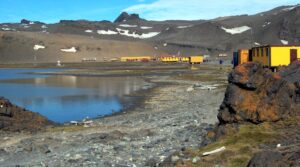
It was time for me to go. “Can I hang onto your back?” I asked when I spotted my shipmates passing by. Pamela was having no problem walking, so John offered his arm to help me over the rocks. “Goodbye Mario,” I said, “Merry Christmas!”
Back on the ship, I slept for hours. I missed the briefing, missed the stop at Aitcho Islands. The Aitchos were named for the British Admiralty Hydrographic Office, or, H. O. In the English Strait between Robert and Greenwich Islands, it’s a beautiful spot with sheer cliffs and spires, huge, green moss beds, and nesting Gentoo and Chinstrap penguins. I was sorry I missed the trip ashore, but glad I was rested for the evening.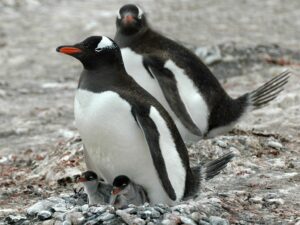
Yuletide celebration on Dekk 7 at 7:15, the announcement said. Wearing red and green, I arrived on time. Mulled wine, Christmas carols sung in German, English, Silent Night; then sung all languages together; O Tannenbaum! I knew the makeup of the guests – 51 Germans, 42 Australians, 24 Americans, 11 British, 9 Dutch, 9 Norwegian, 7 Italian, 5 Swedish, 4 French, 3 Austrian, 3 Chilean, 2 each from Belgium, Denmark and Israel, and 1 each from Canada, Portugal, Slovakia, and Switzerland. Did the music bring us closer? I don’t know. I know that it was memorable.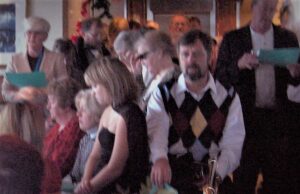
From there to the dining room, Dekk 4. At the front of the room, the Captain stood, Bible in hand. “It is tradition,” he said, “for the Captain to read the Christmas story in Norwegian. Then it will be read in English, in German, and in Spanish.” He began to read, the room stilled, the Christmas tree near my table glittered with candles. I pointed the videocam to catch his reading; kept it running through the English too. Icebergs floated by outside.
Then food! Turkey, roast pork, fish of every kind. Salads, Norwegian smorgasbord. A table arrayed with cakes, candies, a yule log with a mouse on top. So much to eat, and penguin decorations too, reminders of our special day.
Then bells began to ring. The children in the crowd looked up as three Santas burst through  the door, dark-skinned Filipino crew with stringy cotton beards, laughing, toting bags. The children ran back and forth, laughing too. Our Santa stopped with packages for each of us, wrapped in green. The four of us at Table 2 eyed one another, couldn’t wait. I opened mine, and so did they. Flashlights! The mini-kind, so perfect for your pocket, or your purse. We shined the lights at one another’s faces, just like kids would do.
the door, dark-skinned Filipino crew with stringy cotton beards, laughing, toting bags. The children ran back and forth, laughing too. Our Santa stopped with packages for each of us, wrapped in green. The four of us at Table 2 eyed one another, couldn’t wait. I opened mine, and so did they. Flashlights! The mini-kind, so perfect for your pocket, or your purse. We shined the lights at one another’s faces, just like kids would do.
Tired now, at 10 PM. But light outside, the icebergs morning white. I’m typing now, to you.
Happy Christmas! God Jul! Frohe Weihnachten! Feliz Navidad!
» posted on Thursday, December 24th, 2020 by Linda Lou Burton
Christmas Eve with Evie
Christmas in Antarctica originally posted by Linda Lou Burton December 24, 2005 from Arctowski Station, Admiralty Bay, King George Island, Antarctica – Today is Christmas Eve, and I have walked Antarctic soil. The first announcement on the information speaker at 7:30 was this: “I will no longer comment on the weather. This is silly!” Our expedition leader was awed by our good fortune – clear skies, calm waters, 41 degrees.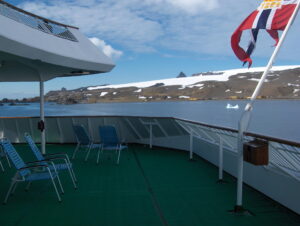
At breakfast, I asked the question. Surely I won’t need my longjohns? Surely not the wool sweater? “Da wetter kud change,” Will admonished me. “Take da swetter!” I was sitting at the table with Will and Paul and Annemarie and their parents, who were chatting away in Dutch with an occasional English comment thrown in for me. I asked Paul what a typical Dutch breakfast would be. He pointed to examples in his plate as he explained it would be sandwich-like, with ham and cheese and vegetables. “What about cereal?” I inquired. “Yes, corn flakes, with sugar already on.” “Frosty flakes?” I said. “Yes!” he laughed. “And chocolate too,” threw in Annemarie. “Cocoa puffs?” I replied. “Yes! Cocoa puffs and chocolate milk!”
 I finished my omelet and sausages, said goodbye, and headed for my room. Time to waterproof. Long underwear, check. Fleece pants, check. Wool socks, check. Wool sweater, check. Waterproof pants next, zipping right, zipping left, Velcro at the bottom. Waterproof bag for cameras into the pack. Fleecy hat, scarf, gloves. Waterproof mittens. Now I rattled when I walked, screech screech, screech, screech. I could not be a spy.
I finished my omelet and sausages, said goodbye, and headed for my room. Time to waterproof. Long underwear, check. Fleece pants, check. Wool socks, check. Wool sweater, check. Waterproof pants next, zipping right, zipping left, Velcro at the bottom. Waterproof bag for cameras into the pack. Fleecy hat, scarf, gloves. Waterproof mittens. Now I rattled when I walked, screech screech, screech, screech. I could not be a spy.
I headed for Dekk 7 to watch the first group leave. The crew had gone first with supplies — set up with enough water and shelter to keep those on shore safe for 24 hours should a sudden storm arise.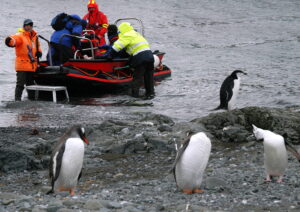
We were divided into six groups, names posted on the wall like a playground list at school. Group 1 is first on the first excursion, followed by Group 2, and so on. Next excursion, Group 2 is first, followed by Group 3, and Group 1 will be last! So, everyone gets a turn to go first. This was explained to us carefully, watching our faces, hoping, I guess, that we wouldn’t be quarrelsome and whiny. I was in Group 6, this was the third excursion for the trip, so, hence, therefore, I would be on the fourth boat today??
“Group 6 may proceed to the Departure Dekk!” was finally called. I scurried down to the boot room, filled with stacks and rows of black rubber Wellies, size clearly handpainted in yellow on the back. I found some 8’s, hoping the fit over the wool socks would work. Puff puff pant pant struggle on with the boots. Into the next room, blop blop blop blop. I was handed a life jacket, helped to adjust it over my Nordic blue Antarctica Voyage of Discovery waterproof, windproof parka. Then fumble through all the layers to find my ID card. Beep, scan me through, officially checked out. Next onto the disinfectant sponge (no germs allowed on shore in the penguin rookery), through the spraywash for the boots, to the ship’s door. Narrow steps, rope for railing, blop blop blop blop to the PolarCirkel boat. I was the last one in.
It was a beautiful ride, five minutes across to Arctowski Base, the hillside above our landing site covered with penguin rookeries. We were not allowed anywhere near the rookeries; our orders were to stick to the path to the Base and allow penguins to come to us.
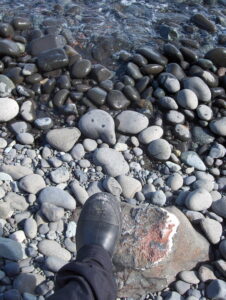 Landing, grab the PolarCirkel rails, step to a metal step perched perilously in the rocky waters. “Jump!” I was told. I jumped, splashed in clear water nearly to my knees. Aha! My well-baptized feet are in the Southern Ocean! But I cannot reach my camera, cannot even walk. A gentleman behind offers his arm. I take it, gratefully, and climb the rocky bank. On shore, I realize I will not be able to walk to the Base, a mile or so away. The rocks are too big, too rough for my uncertain hobble-walk. My feet are slipping inside the Wellies, blop blop blop. I analyze my options.
Landing, grab the PolarCirkel rails, step to a metal step perched perilously in the rocky waters. “Jump!” I was told. I jumped, splashed in clear water nearly to my knees. Aha! My well-baptized feet are in the Southern Ocean! But I cannot reach my camera, cannot even walk. A gentleman behind offers his arm. I take it, gratefully, and climb the rocky bank. On shore, I realize I will not be able to walk to the Base, a mile or so away. The rocks are too big, too rough for my uncertain hobble-walk. My feet are slipping inside the Wellies, blop blop blop. I analyze my options.
“Manuel tells you there are 17 species of penguin,” our leader had said in an earlier briefing, following a lecture by our resident penguin researcher. “But I say there are two. Black penguins, and white penguins. If you see penguins, and run towards them shouting Look Look Penguins!, then you will see nothing but black penguins. If you see penguins, and stand very still, patiently waiting for them to come to you, then you will see white penguins.”
 OK, I decided, as my eyes scanned the rocky shore, I will stand very still. Maybe the penguins will come to me. Patience pays.
OK, I decided, as my eyes scanned the rocky shore, I will stand very still. Maybe the penguins will come to me. Patience pays.
A single penguin came around a rock, hobbling, wobbling, struggling even more than me on the uneven ground. Balancing her flippers sideways, left, right, left, right, she reached the top of our little ridge and looked around. More rocks ahead. An uneven walk to the beach, and lunch.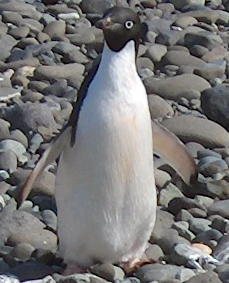
Evie looked up at me. I looked back at Evie. We looked at the hateful rocks together. “ohrmmph” she said, with a shake of her head. “That’s a long walk!”
I knew what she meant. She looked at me again, her white-ringed eyes unblinking and clear. Then she shook her head, flapped her flippers in a get-started motion, and hobbled across the rocks to the ocean shore.
You go, girl.
» posted on Wednesday, December 23rd, 2020 by Linda Lou Burton
Get Ready for Jeopardy!
 Christmas in Antarctica originally posted by Linda Lou Burton December 23, 2005 from Southern Ocean, Antarctica – When I told people I was going to visit Antarctica, responses varied from “Where is that?” to “Why would you want to do something like that?” to “What will you DO there?” to “It will be mighty cold there.” It’s like humor, I guess, if you have to explain it to someone, you know they will never get it anyhow! The people I’m traveling with on this ship are of one mind about Antarctica – they love it, are awed with it, and would come back in a minute.
Christmas in Antarctica originally posted by Linda Lou Burton December 23, 2005 from Southern Ocean, Antarctica – When I told people I was going to visit Antarctica, responses varied from “Where is that?” to “Why would you want to do something like that?” to “What will you DO there?” to “It will be mighty cold there.” It’s like humor, I guess, if you have to explain it to someone, you know they will never get it anyhow! The people I’m traveling with on this ship are of one mind about Antarctica – they love it, are awed with it, and would come back in a minute.
Now you, take a peek at the bottom end of your World Globe, and get your gourd ready for a game of Jeopardy.
Some things to know about Antarctica, AKA, The Ice, gleaned from Alan Parker’s lecture on Antarctica, and my Lonely Planet book. (2020 update: Alan Parker died July 26, 2020. I am pleased I was privileged to hear him speak in 2005.)
- Antarctica has no wars.
- Antarctica’s environment is fully protected.
- Antarctica is a nature reserve devoted to peace and science.
- Antarctica has no native population.
- Antarctica has no native government; no country holds title over any part of it.
- Antarctica is governed by the Antarctic Treaty, with 45 member nations, who meet annually to discuss scientific cooperation, environmental protection, management of tourism, and preservation of historic sites.
- Antarctic residents are temporary; people come to work in Antarctica from dozens of countries.
- Antarctica’s winter population is about 1,200 – one-third scientists and the rest support personnel; summer population is about 7,200.
- Antarctica was visited by over 13,000 tourists in 2003 – 40% from the US, 15% each from Germany and the U. K., 6% from Australia, and 3% each from Japan, Canada and Switzerland.
- Antarctic tourism is controlled by IAATO, International Association of Antarctica Tour Operators, and limits visitors to 100 at any place at any one time.
- Antarctica is the world’s most arid continent.

- Antarctica is the world’s highest continent.
- Antarctica is 99.6% covered by ice.
- Antarctica’s Lambert Glacier is the largest glacier in the world.
- Antarctica’s Ice Sheet is 1.4 times the size of the United States.
- Antarctica’s Ice Sheet contains 70% of the world’s fresh water.
- Antarctica’s ice is so thick, accumulating over millions of years, that its weight pushes the land mass underneath below sea level.
- Antarctica’s Ice Sheet melts very little, even though it has constant sunrays during summer months, because the sun’s heat is reflected back by the ice.
Question please?
» posted on Wednesday, December 23rd, 2020 by Linda Lou Burton
From the Bridge
Christmas in Antarctica originally posted by Linda Lou Burton December 23, 2005 from Drake Passage, Antarctica – We entered the Southern Ocean a few hours ago. AKA the Convergence Zone. The Drake Passage is the Drake Lake today. Sometimes, I’m told, it is the Drake Shake. When that happens, you pay your Drake Tax. I’m wearing my acupressure wristbands to avoid seasickness, even though the roll is gentle. Like the man waving the stick to keep the elephants away, it’s working!
Since there is nothing to look at today but water, water, everywhere, our leader has planned events to keep us busy. Morning, a trip to the Bridge. Then, lectures.
- Penguins: The brush-tailed – Life and Death Part II, by Dr Manuel Marin
- The Antarctic Frigid Zone – Why is it so?, by Alan Parker
- Heroic Hearts: Amundsen and Scott, by Ian Shaw
And of course, our Pre-landing briefing at 6 PM.
The Happy Hour drink today is Planter’s Punch, and the phrase of the day is “Are you cold? Er du kald? Ist Dir kalt? Tienes frio?”
I want to hear Alan Parker’s lecture today. Alan has made 56 trips to Antarctica, been awarded a Polar Medal for his contributions to science in Antarctica, and even has a mountain named for him! Parker Peak. A native of Australia, he has lived on Macquarrie Island for a 12-month stint, and worked at Davis Station for fifteen. Who better to listen to for learning more about Antarctica?
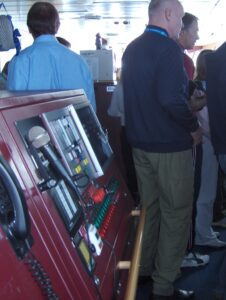 But about the water now: according to my handout, the Antarctic Convergence is where the warmer waters of the north meet the colder, denser, less saline waters of the south. Colder water sinks, of course, causing an up-welling that brings nutrients to the surface. This point, which is ever-changing, is the biological limit of the Antarctic ecosystem. There is no way to know when you cross it except by thermometer. But, I am assured by the second-in-command on the Bridge, we have passed it now. Our Captain is busy shaking hands, greeting visitors, smiling at us all.
But about the water now: according to my handout, the Antarctic Convergence is where the warmer waters of the north meet the colder, denser, less saline waters of the south. Colder water sinks, of course, causing an up-welling that brings nutrients to the surface. This point, which is ever-changing, is the biological limit of the Antarctic ecosystem. There is no way to know when you cross it except by thermometer. But, I am assured by the second-in-command on the Bridge, we have passed it now. Our Captain is busy shaking hands, greeting visitors, smiling at us all.
More facts. The Convergence Zone, this Polar Front, is a function of the Antarctic Circumpolar Current. The waters of Antarctica circle the continent in the world’s biggest ocean current at an estimated rate of 150 million cubic meters per second! That’s  equivalent to FOUR GULF STREAMS or ONE THOUSAND AMAZON RIVERS! As this dense water begins to move north, it has tremendous impact on global weather systems. Carried into the Atlantic and Pacific Oceans, it has a cooling effect on tropical and temperate waters, very important to the oceans’ balance.
equivalent to FOUR GULF STREAMS or ONE THOUSAND AMAZON RIVERS! As this dense water begins to move north, it has tremendous impact on global weather systems. Carried into the Atlantic and Pacific Oceans, it has a cooling effect on tropical and temperate waters, very important to the oceans’ balance.
I’m impressed! “Exactly where is it considered the point where the Atlantic and Pacific meet?” I asked. A shrug. “I don’t know,” was the reply, “perhaps at Cape Horn?”
This is humorous to me. I picture the ship pointed south from Cabos de Hornos, riding a fine dotted line with Atlantic left, Pacific right, then, blip, another hop into Southern Ocean waters.
» posted on Tuesday, December 22nd, 2020 by Linda Lou Burton
Sound the Trumpets! Mission Accomplished
Christmas in Antarctica originally posted by Linda Lou Burton December 22, 2005 from Cape Horn, Chile – I’d had my fingers crossed since June 22 and the trip to Barrow, Alaska, where I was NORTH of the Arctic Circle on the first day of Summer. There didn’t seem to be any way possible to get myself SOUTH of the Antarctic Circle on the first day of the southern hemisphere’s Summer, because nobody GOES there. But Cape Horn would do. The southernmost point of what is considered South America, Latitude 55.43 degrees south. Barrow was at Latitude 71.19 degrees north and even Fairbanks, Alaska was 64.83 degrees. But hey, the earth is made up of mostly LAND at the north end and mostly WATER at the south. So be it. Cape Horn would satisfy me. I wanted to set my foot on that chunk of land on December 22.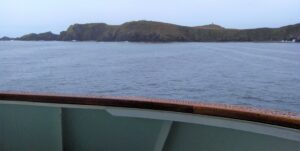
We had come through the Beagle Channel to arrive at the Horn at 2:30 PM, and our leader announced with great glee, “We can land!” In the last fifteen crossings, he told us, the weather had been fit for a landing only three times. He was jumping around, PREPARING things. I did my analysis too. The sea didn’t look too rough, the rain wasn’t coming down too hard, the distance to shore wasn’t too far. But then.
I zoomed in on the steps. The shoreline was rocky, the landing beach quite small. A sheer rock cliff rose straight up from the beach, and that’s where the steps were, fastened somehow to the rock wall. One hundred and twelve rickety wooden steps, some broken or split, all slippery in the waves and rain.
Just at the top on a rounded grassy knoll I could see the monument to the albatross, honoring all the sailors who perished while trying to round the cape. Sara Vial’s poem was inscribed at the bottom of the monument, I read from our handout:
“I am the albatross that waits for you at the end of the earth. I am the forgotten soul of the dead sailors who crossed Cape Horn from all the seas of the world. But they did not die in the furious waves. Today they fly in my wings to eternity in the last trough of the Antarctic winds.”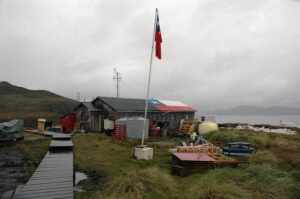
A few hundred yards left of the monument was the the home of the lighthouse keeper, supposedly occupied by the keeper, his wife, a cat, and a dog. A lonely existence! “There may be souvenirs available from there,” we were told, “but be patient, the house is very tiny.”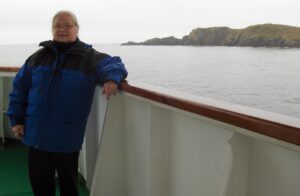
Reluctantly, I decided not to make the trip. I’d consider my Mission Accomplished by my presence on the ship. I spent the day in the Torghatten Salong, with my cameras and 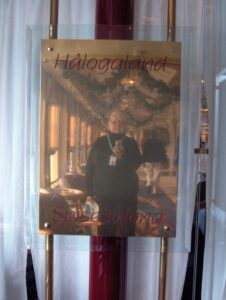 with many others who didn’t want to venture up those steps. I walked in the open air of Deck 5. “Will you take my picture with the Cape behind me?” I asked one of the stay-behinds. She did.
with many others who didn’t want to venture up those steps. I walked in the open air of Deck 5. “Will you take my picture with the Cape behind me?” I asked one of the stay-behinds. She did.
That evening, at dinner, those who braved the climb relayed their story. “I have a certificate!” they said. “I have walked on Cape Horn!”
Well, I’ve been close. “Cape Horn is one of the greatest graveyards for ships anywhere in the world,” were the words on my handout. “It is a rite of passage for sailors the world over.” “Aha! My rite of passage,” I thought. “I have rounded the Horn.”
Overall, I’m pretty pleased. First Day of Summer, I declare you a success.

